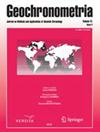基于同位素和方解石组构分析的Kraków-CzÉstochowa高地(波兰)低更新世至中更新世古气候记录
IF 0.9
4区 地球科学
Q3 Earth and Planetary Sciences
引用次数: 5
摘要
摘要基于洞穴记录的古环境重建质量取决于所使用的替代物的准确性和所研究记录的年代。就测年方法而言,在大多数情况下,最好的解决方案是使用U系列方法来获得精确的年表。然而,对于较老的时期(即超过0.5 Ma),测年已成为一项严峻的挑战。从理论上讲,较老的物质可以用U-Pb定年法测年。然而,这种方法需要相对较高的铀含量(至少几ppm),而来自波兰(和整个中欧)的典型洞穴的铀浓度低于0.1 ppm。由于波兰洞穴中的物质存在问题,我们将氧同位素地层学(OIS)作为洞穴年代测定的工具。通过使用OIS作为创建我们的流石年表的替代工具,发现所研究的流石结晶于975至470ka,具有三个主要的不连续性,因此所获得的同位素记录可以与MIS 24至MIS 12的氧同位素阶段相关联。观测到的同位素变化也与流石的岩相观测结果一致并得到证实。本文章由计算机程序翻译,如有差异,请以英文原文为准。
Low to middle Pleistocene paleoclimatic record from the Kraków-Częstochowa Upland (Poland) based on isotopic and calcite fabrics analyses
Abstract The quality of paleoenvironmental reconstruction based on speleothem records depends on the accuracy of the used proxies and the chronology of the studied record. As far as the dating method is concerned, in most cases, the best solution is the use of the U-series method to obtain a precise chronology. However, for older periods (i.e., over 0.5 Ma), dating has become a serious challenge. Theoretically, older materials could be dated with the U-Pb dating method. However, that method requires a relatively high uranium content (minimum of several ppm), whereas typical speleothems from Poland (and all of Central Europe) have uranium concentrations below 0.1 ppm. Because the materials in Polish caves are problematic, we applied oxygen isotope stratigraphy (OIS) as a tool for speleothem dating. By using OIS as an alternative tool to create a chronology of our flowstone, it was found that the studied flowstone crystallized from 975 to 470 ka with three major discontinuities, so obtained isotopic record can be correlated with oxygen isotopic stages from MIS 24 to MIS 12. The observed isotopic variability was also consistent and confirmed with the petrographic observations of the flowstone.
求助全文
通过发布文献求助,成功后即可免费获取论文全文。
去求助
来源期刊

Geochronometria
地学-地球科学综合
CiteScore
2.20
自引率
0.00%
发文量
1
审稿时长
>12 weeks
期刊介绍:
Geochronometria is aimed at integrating scientists developing different methods of absolute chronology and using them in different fields of earth and other natural sciences and archaeology. The methods in use are e.g. radiocarbon, stable isotopes, isotopes of natural decay series, optically stimulated luminescence, thermoluminescence, EPR/ESR, dendrochronology, varve chronology. The journal publishes papers that are devoted to developing the dating methods as well as studies concentrating on their applications in geology, palaeoclimatology, palaeobiology, palaeohydrology, geocgraphy and archaeology etc.
 求助内容:
求助内容: 应助结果提醒方式:
应助结果提醒方式:


